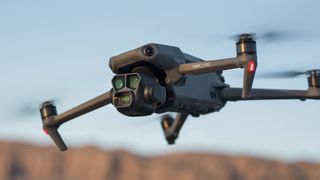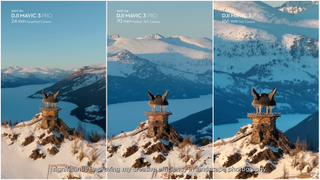The triple-camera DJI Mavic 3 Pro is the world’s most versatile drone
The DJI Mavic 3 Pro has finally officially landed – and as the rumors predicted, it’s DJI’s first triple-camera consumer drone and a new flagship that sits at the top of its Mavic 3 series.
Not familiar with DJI drones? The Mavic series are its top-range consumer drones, sitting above the mid-range Air series and the beginner-friendly Mini range. And the Mavic 3 Pro is now the flagship model in this series, above the DJI Mavic 3 and the more affordable DJI Mavic 3 Classic.
So what makes the Mavic 3 Pro deserving of flagship status? Its main appeal are its three cameras, which promise to make it DJI’s most versatile drone so far. The Mavic 3 Pro has a main Four Thirds camera (with a 24mm focal length), which is flanked by a new 1/1.3in mid-telephoto camera (70mm focal length) and an improved 166mm telephoto camera.
That telephoto is similar to the one on the DJI Mavic 3, with the same small 1/2-inch sensor, but has a slightly longer focal length and a brighter aperture (f/3.4, compared to f/4.4). This should help boost image quality for long zoom shots, particularly in less-than-ideal lighting.
But it’s that new mid-telephoto camera that arguably has even more potential. It’s effectively the DJI Mini 3 Pro’s main camera with a longer focal length, and promises to neatly fill in the gap between the Mavic 3 Pro’s wide and extreme telephoto lenses, letting you get closer to subjects you may not be able to fly close to (for example, people and buildings) without having to use digital zoom.
So what are the other benefits (and downsides) to the DJI Mavic 3 Pro and is it the drone for you? Here are all of the official details, plus our early verdict.
Cut to the chase
- What is it? DJI’s first drone with three camera lenses.
- When is it out? It’s available to pre-order now with shipping starting in May.
- How much will it cost? The DJI Mavic 3 Pro starts at $2,199 / £1,879 / AU$3,099 (with the DJI RC controller), with Fly More Combo and a Cine Premium Combo bundle also available (see below).
DJI Mavic 3 Pro price and release date and price
The DJI Mavic 3 Pro is available to pre-order now ahead of shipping in May in the various bundles below, which start at £2,199 / £1,879 / AU$3,099 for the drone and DJI RC controller.
| Bundle | DJI Mavic 3 Pro |
| With DJI RC controller | $2,199 / £1,879 / AU$3,099 |
| Fly More Combo (DJI RC) | $2,999 / £2,549 / AU$4,199 |
| Fly More Combo (DJI RC Pro) | $3,889 / 3,169 GBP/ AU$5,329 |
| Cine Premium Combo | $4,799 / £4,109 / AU$6,939 |
Strangely, DJI says that while the existing DJI Mavic 3 will remain on sale, it won’t be producing that drone any more. This explains why the DJI Mavic 3 Pro’s pricing is similar to the Mavic 3.
Ultimately, this will leave the Mavic 3 series with two options – the new Pro version, and the more affordable, single-camera DJI Mavic 3 Classic.
DJI Mavic 3 Pro specs and features
The DJI Mavic 3 Pro rumors were pretty much spot-on – this is DJI’s first consumer drone with three cameras, making it an aerial companion with few peers when it comes to shooting versatility.
Let’s take a look at that new camera setup first. As you can see below, the Mavic 3 Pro combines the main camera from the standard Mavic 3 – which has a large Four Thirds sensor – with a new 70mm mid-telephoto, and a slightly upgraded 166mm telephoto lens (which has a brighter f/3.4 aperture than on the Mavic 3).
| Camera | Sensor | Focal length | Aperture |
| Main camera | 20MP Four Thirds | 24mm | f/2.8-f/11 |
| Mid-telephoto (3x zoom) | 48MP 1/1.3in | 70mm | f/2.8 |
| Telephoto (7x zoom) | 12MP 1/2in | 166mm | f/3.4 |
On that main camera, you can shoot 5.1K video at 50fps or DCI 4K at 120fps, although it’s worth noting that ActiveTrack autofocus isn’t available when you’re shooting at resolutions higher than 4K or frame rates over 60fps.
The Mavic 3 Pro’s medium telephoto camera sounds particularly fun, thanks to its 1/1.3in sensor (the same as on the DJI Mini 3 Pro) and ability to shoot 48MP stills or 4K/60p video. It also supports DJI’s new D-log M format, which promises to be a versatile option for color grading.
Lastly, that telephoto lens promises to be slightly better than the one on the Mavic 3, thanks to its aperture boost (it’s f/3.4, compared to f/4.4 on its predecessor). It still only has a small 1/2-inch sensor but could be a handy emergency option for b-roll.
Below you can see a more detailed breakdown for the Mavic 3 Pro’s three cameras. While only the Cine version supports Apple ProRes, the mid-telephoto lens does support D-Log and shoots 4K/60p video. So it’s definitely shaping up to be more usable than the telephoto lens.
| Row 0 – Cell 0 | Main camera (24mm) | Mid-telephoto camera (70mm) | Telephoto camera (166mm) |
| Sensor | Four Thirds 20MP CMOS | 1/1.3in CMOS | 1/2in CMOS |
| Resolution | 20MP | 48MP/12MP | 12MP |
| Lens | 24mm (f/2.8-f/11) | 70mm (f/2.8) | 166mm (f/3.4) |
| Video | 5.1K/50p, 4K/60p, 1080/60p | 4K/60p, 1080/60p | 4K/60p, 1080/60p |
| Slo-mo | 4K/120p, 1080/200p | Not supported | Not supported |
| Codecs | H.264/H.265 Apple ProRes 422 HQ/422/422 LT | H.264/H.265 Apple ProRes 422 HQ/422/422 LT* | H.264/H.265 Apple ProRes 422 HQ/422/422 LT* |
| Color formats | HNCS, D-Log, D-Log M, HLG, Night Video Mode | Normal, D-Log M, HLG | Normal |
| Shooting styles | MasterShots, QuickShots, Panorama, Hyperlapse, Focus Track | Hyperlapse, Focus Track | Spotlight and POI of Focus Track supported, ActiveTrack not supported |
Elsewhere, DJI says the Mavic 3 Pro can manage 43 minutes of flight time (a few minutes less than the Mavic 3), though that will again likely equate to around 30 minutes of actual shooting time. And it has the same obstacle avoidance system as before, using eight wide-angle sensors that work seamlessly to spot tree branches and objects.
Just like on the Mavic 3, the Mavic 3 Pro also has DJI’s latest O3+ transmission system, which promises to deliver a 1080p/60fps HD live feed at distances of up to 15 km (in the US) or 8km elsewhere. Although most regions’ drone laws do require you to maintain line-of-sight with your drone, so those distances are simply theoretical.
DJI Mavic 3 Pro: early verdict
While it’s a slight shame that DJI has effectively retired the Mavic 3, the Mavic 3 Pro is shaping up to be powerful upgrade with unprecedented versatility, thanks to those three cameras.
As you can see below, the option of having a 24mm, 70mm and 166mm lens on a drone opens up the possibility of shooting an establishing shot, an alternative close-up and a b-roll, all without moving the drone and with the added benefits of compression and a parallax effect from those longer focal lengths
On paper, there are only a couple of small downsides to this added versatility – the Mavic 3 Pro’s battery life is slightly shorter than the Mavic 3’s by a few minutes, and it’s also a little heavier, which means that in Europe it’s ‘C2 class’ drone. In most regions, that’ll mean you need to fly at least 50m away from people.
Still, as long as you have decent light, those two longer focal lengths should help compensate for this, and the Mavic 3 Pro is otherwise shaping up to be one of the best drones you can buy. We’re in the process of testing DJI’s new drone right now and will bring you our full verdict very soon.


